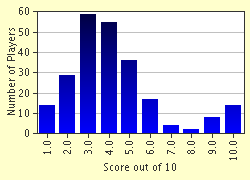Quiz Answer Key and Fun Facts
1. Though the 5th century B.C.E. was a time of great theoretical development, some fanciful ideas remained regarding the nature of the earth and the universe. Take the example of Empedocles, poet and philosopher, who conjectured what about the nature of the universe?
2. Aflame with scientific zeal, another of the early 5th century B.C.E. cosmologists was Anaxagoras, friend of both Pericles and Euripides. From whence came this great philosopher, who probably developed the first scientific theory regarding eclipses?
3. This ancient Pythagorean was perhaps the first person in history to suggest that the Earth was not at the center of the universe, and he developed interesting ideas about a 'central fire' and a 'counter-earth'. Who was this great 5th-century intellectual?
4. The obscure ancient Greek astronomer Oenopides is associated with the first calculation of Earth's obliquity, and he also first calculated what is now known as a 'Great Year'. How long is a great year, according to Oenopides' calculations?
5. Moving along among the greats of ancient Greece we arrive at Democritus, student of Leucippus. Democritus was most well-known as a philosopher, but came up with a key cosmological assertion that turned out, ultimately, to be true. What was this assertion?
6. One of history's first astronomical observatories was to be found on the highest hill in Athens, and was used by such luminaries as Meton and Phaeinus. Upon which hill was this legendary observatory built?
7. And then along came Plato. Possibly the most famous and influential of the ancient Athenian philosophers, did Plato have an important influence on the sciences, including the field of astronomy?
8. In order to allow ancient astronomers to begin explaining the odd motions of the various bodies in our solar system within the context of a geocentric cosmological view, a theory about a system of concentric spheres was developed. Which student of Plato first developed this system?
9. While the Greek scientific community was perhaps the most collectively active of the 4th century B.C.E., it was not the only one making interesting astronomical observations. Astronomers from which ancient land were said to have first observed Jupiter's moons c. 365 B.C.E.?
10. In 350 B.C.E., a Chinese astronomer created perhaps history's first star catalogue. What was the name of this pioneer of stellar observation?
Source: Author
thejazzkickazz
This quiz was reviewed by FunTrivia editor
crisw before going online.
Any errors found in FunTrivia content are routinely corrected through our feedback system.

